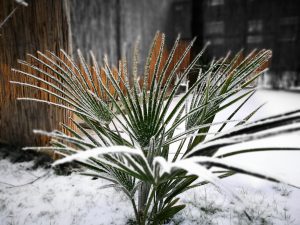How to Protect Plants in Winter
As winter settles in, bitter cold, heavy snow, and wind can pose significant threats to your landscape. Protecting your plants during this season is essential to maintaining a thriving garden or yard. Without proper precautions, plants can suffer from frost damage, breakage, dehydration, or even predation by wildlife. We understand the importance of preparing your greenery for winter, ensuring it emerges healthy and vibrant when spring returns. To help you prepare, here’s a guide to some of the best methods for protecting your plants in the winter.
Why Protect Plants in Winter?
Winter protection for plants isn’t just about shielding them from cold; it’s about mitigating all the unique challenges this season presents:
- Freezing Temperatures: Frost can damage plant cells, leading to discoloration, wilting, and dieback.
- Snow and Ice: Heavy accumulations can break branches and crush plants.
- Dry Winds: Winter winds can cause dehydration, especially in evergreens.
- Wildlife Damage: Deer, rabbits, and other animals often forage in gardens during winter when food is scarce, damaging plants.
By addressing these threats, you preserve the health, structure, and aesthetics of your plants, reducing the need for costly replacements or repairs in spring.


Deer Netting
Deer netting acts as an effective barrier, preventing wildlife from grazing on your plants during winter. When food is scarce, deer and other animals turn to trees and shrubs or garden plants as a food source, causing irreparable harm. Deer are drawn to tender plants, often stripping gardens bare and leaving behind a barren appearance. They may damage tree bark during rutting season or trample delicate plants. Beyond physical damage, deer can also introduce pests like ticks and spread diseases, posing risks to both your landscape and the health of humans and pets.
With deer netting in place, plants retain their foliage and bark integrity, ensuring they survive the winter unscathed. The material is lightweight and breathable, allowing sunlight and air to pass through while keeping animals out. This ensures that plants continue to photosynthesize on sunny winter days without interference. It also protects the plant’s structural integrity, reducing the likelihood of additional damage when wildlife applies pressure to branches or trunks.


Snow Fencing
Snow fencing is a strategic solution to protect plants from the damaging effects of snow and wind. By redirecting snowdrifts, snow fencing prevents large accumulations from burying plants, which can crush branches or compact the soil, suffocating roots.
Additionally, snow fencing acts as a buffer against high winds, shielding plants from desiccation and physical damage caused by flying debris. For plants located in open or exposed areas, this added protection can mean the difference between surviving winter and succumbing to it.
The fencing’s design helps maintain a healthy microenvironment around plants, reducing stress on their structures while minimizing exposure to extreme conditions.


Burlap Covers
Burlap covers are an essential tool for shielding plants from harsh winter winds and fluctuating temperatures. This natural material offers a breathable layer of protection, preventing plants from losing moisture through windburn or sunscald during sunny but cold days.
Unlike synthetic materials, burlap allows for proper air circulation, which reduces the risk of mold or mildew forming on plants. It also insulates plants, keeping them warm during extreme cold snaps without trapping excessive heat. Burlap is particularly beneficial for evergreen shrubs, which continue to photosynthesize and require additional care to prevent dehydration during winter.
Beyond protection from the elements, burlap can also shield plants from road salt, which is often sprayed near driveways and sidewalks. Salt damage can be devastating to plant health, and burlap provides a reliable barrier to reduce exposure.
Additional Winter Protection Tips
For more winter plant care, consider the following strategies alongside these winter protection methods. These techniques ensure your landscape remains vibrant and healthy through the toughest months.
Mulching
Applying a layer of mulch around the base of plants provides insulation for roots, protecting them from extreme temperature fluctuations. Mulch acts as a natural barrier, reducing heat loss from the soil and keeping the root zone warmer during cold spells. It also helps retain soil moisture, preventing plants from drying out during winter winds.
Organic mulches, such as wood chips or straw, break down over time, enriching the soil with nutrients. This added benefit ensures that plants start the spring season with improved soil health.
Creating Windbreaks
For plants in exposed areas, temporary or permanent windbreaks can be a game-changer. Hedges and fences can shield plants from gusty winds, reducing the risk of dehydration and physical damage.
By creating a more stable environment, windbreaks allow plants to conserve their energy and remain healthy during winter’s harshest days.
Regular Watering Before the Freeze
Keeping plants well-hydrated before the ground freezes is vital. Dry soil exacerbates winter damage, as plants need moisture to sustain themselves even when growth slows.
Focus on watering deeply in late fall to ensure that plants enter winter with adequate hydration, especially evergreens and newly planted specimens.
Protecting Potted Plants
Container plants are particularly vulnerable to winter damage because their roots are above ground and exposed to the cold. Move potted plants indoors to sheltered locations, such as a garage or porch, to provide additional insulation. Covering plants in burlap can further protect roots from freezing temperatures.
Why Choose Benson Enterprises for Winter Plant Protection?
At Benson Enterprises, we specialize in creating year-round solutions for healthy landscapes. Our team has years of experience meeting the unique needs of each property. We offer professional installation of deer netting, snow fencing, and burlap covers, ensuring your plants are properly safeguarded against winter’s challenges. By partnering with us, you can save time and effort and enjoy peace of mind knowing your plants are protected, and that your landscape is preserved for years to come.
Let us help you prepare your plants for winter. Contact us today to learn more about our winter protection services and start the winter season with confidence.
Call Today For A Free Estimate (585) 248-0452
Latest Posts


How to Protect Plants in Winter
How to Protect Plants in Winter As winter settles in, bitter cold, heavy snow, and


7 Outdoor Design Ideas for the Winter Season
7 Outdoor Design Ideas for the Winter Season When winter arrives, it’s easy to assume


Preparing for Spring with Fall Lawn Care
Preparing for Spring with Fall Lawn Care When summer fades away and cooler temperatures take


Autumn: The Best Time to Plant Trees
Autumn: The Best Time to Plant Trees As the air becomes cooler and the leaves


5 Landscape Lighting Ideas to Brighten Your Backyard
5 Landscape Lighting Ideas to Brighten Your Backyard When it comes to your backyard, it




